IOMOD 4Cs4Vs User Manual
Introduction
IOMod 4Cs4Vs is a compact-sized stand-alone power meter for measuring analog AC input signals from low-power current and voltage sensors. It measures three phases of AC voltages and currents with additional inputs for neutral/residual voltage and current. The measured and calculated values are transmitted to the host system via communication protocol IEC 60870-5-103 or Modbus RTU.
Features
- 4 AC current sensor inputs according to IEC 60044-8 (nominal value 225mV)
- 4 AC voltage sensor inputs according to IEC 60044-7 (nominal value 3.25/ √3 V)
- Communication protocols : IEC 60870-5-103 or Modbus RTU
- 32 samples per cycle
- FFT-based calculation with harmonic information
- RS485 interface with a switchable terminating resistor
- Status and data transmission (Rx and Tx) indication.
- Configurable over USB
- Drag-and-Drop firmware upgrade over USB
- A small-sized case with a removable front panel
- DIN rail mount
- Operating temperature: from -30 to +70°C
- Power Requirements: 12-24 VDC
Common configuration information
- Nominal system frequency. In order to get correct three-phase system measurements, a user must select nominal system frequency – either 50 Hz or 60 Hz.
- Process parameters. There user can set rated primary current and voltage values which are used for calculating measured data in primary values. Those values are available only via float registers in the Modbus RTU protocol.
- Configuration of sensors. The power meter is designed to work with standard low-power current and voltage sensors with a nominal output value of 225 mV for the current sensor and 3.25√3 V (1.876 V) for the voltage sensor. If current sensors have some deviation from the nominal value, a user can define the exact sensor voltage. The new value will be set the same for all current sensors inputs. Each voltage sensor input has a separate correction parameter called the magnitude factor. This factor is used to multiply measured voltage. For example, if a sensor has a 5% lower output voltage, the user can set the magnitude to 1050. The actual factor will be 1.05 and the measured value will be multiplied by this factor. This factor can be used in cases when several measuring devices are connected to the same sensor in parallel. In this case, the parallel connection will reduce the internal resistance of the sensor and consequently output voltage. The magnitude factor can be used to compensate for this deviation.
- Communication protocol. Selection of IEC 60870-5-103 or Modbus RTU communication protocol.
Connection diagram
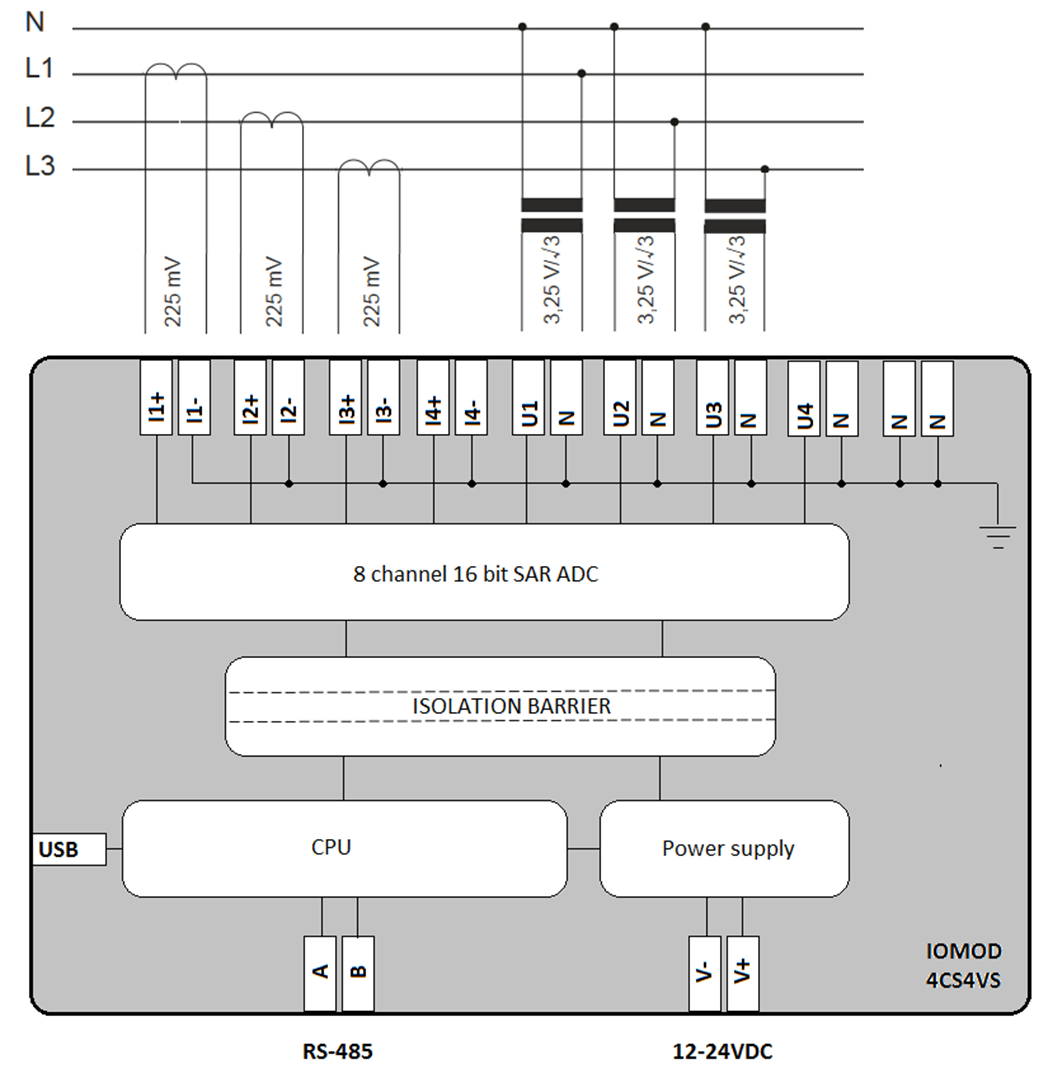 Fig. 4.1. IOMOD 4CS4VS internal structure and connection diagram
Fig. 4.1. IOMOD 4CS4VS internal structure and connection diagram
Technical information
| System | ||
| 1. | Dimension | 101 x 119 x 17.5 mm |
| 2. | Case | ABS, black |
| 3. | Working environment | Indoor |
| 4. | Working temperature | -30 | +70 |
| 5. | Recommended operating conditions | 5 – 60°C and 20 – 80%RH; |
| 6. | Configuration |
USB – configuration terminal via com port |
| 7. | Firmware upgrade | USB – mass storage device |
| Electrical specifications |
||
| 8. | Inputs |
16-bit resolution, Input resistance: ~1 MOhm Input capacitance: ~170 pF Input Ranges: ±10 V (amplitude); Nominal values:
Overvoltage protection of all inputs up to ±20 V (amplitude) |
| Power |
||
| 9. | Power Supply | 9 V to 33 V |
| 10. | Current consumption | 40 mA @ 12 VDC, 20 mA @ 24 VDC |
RS485 Interface
IOMod 4Cs4Vs has an integrated 120 Ω termination resistor, which can be enabled or disabled via the configuration terminal. It is recommended to use termination at each end of the RS485 cable. See the typical connection diagram in Fig. 6.1.
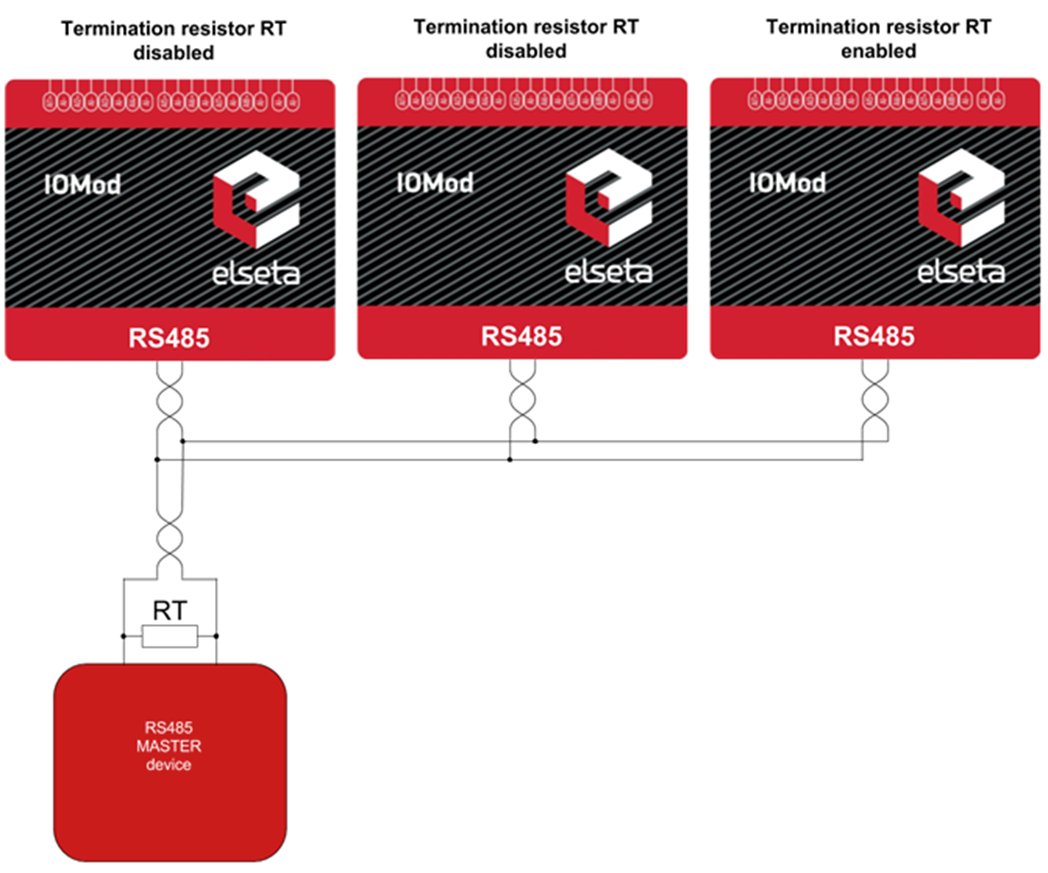 Fig. 6.1. Typical IOMod connection diagram
Fig. 6.1. Typical IOMod connection diagram
IOMod 4Cs4Vs has a 1/8 Unit load receiver which allows having up to 255 units on a single line (compared to standard 32 units). To reduce reflections keep the stubs (cable distance from the main RS485 bus line) as short as possible.
Configuration over USB
Driver installation
The device requires USB drivers to work as a Virtual COM port. The first-time connection between the device and the computer could result in a “Device driver software was not successfully installed” error (as in Fig. 7.1).
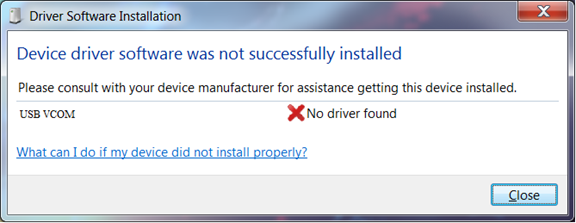 Fig. 7.1. Unsuccessful device software installation error
Fig. 7.1. Unsuccessful device software installation error
A user then should manually install drivers by selecting a downloaded driver folder:
- Go to Control Panel -> Device Manager;
- Select a failing device;
- Press “Update driver software”; the screen as in Fig. 7.2. should appear:
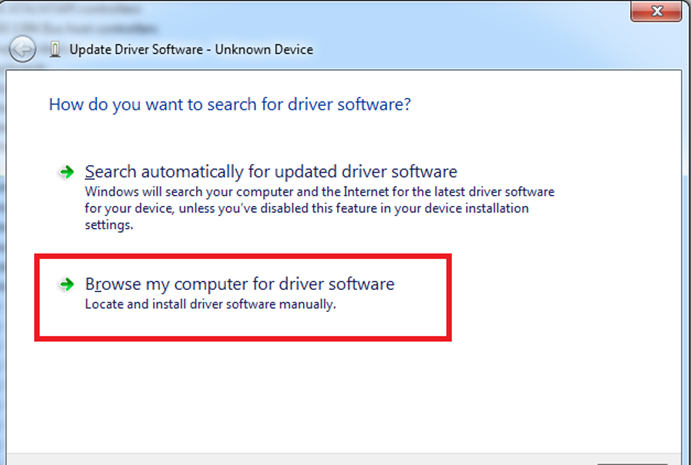 Fig. 7.2. Device driver software update message
Fig. 7.2. Device driver software update message
● Select “x86” driver for a 32-bit machine or x64 for a 64-bit machine. If not sure, select a root folder (folder in which x64 and x86 lay inside, as in Fig. 7.3).
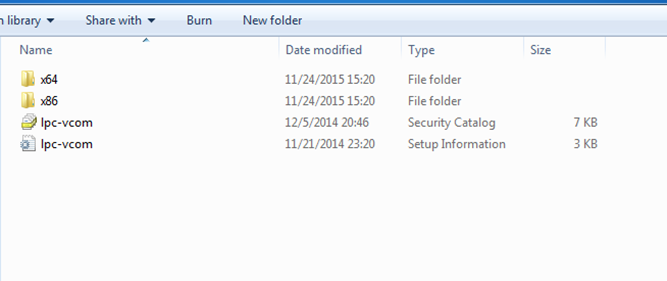 Fig. 7.3. Device driver folder content
Fig. 7.3. Device driver folder content
IOMod configuration via PuTTY terminal
A configuration of the IOMod device is done through CLI (Command Line Interface) on the virtual COM port. Drivers needed for Microsoft Windows to install VCOM will be provided. To open up CLI simply connect to a specific V-COM port with terminal software (advised to use PuTTY terminal software. If other software is being used, a user might need to send <return> symbol after each command). When connected user should immediately see the main screen (Fig. 7.4).
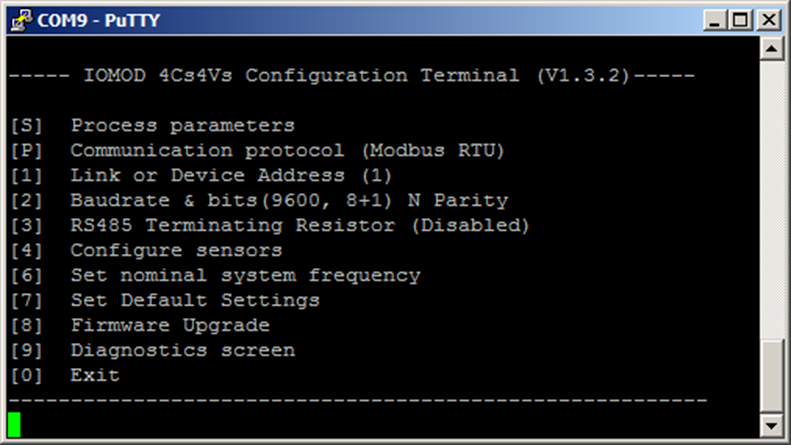 Fig. 7.4. The main menu
Fig. 7.4. The main menu
It is highly advised to exit the main screen before disconnecting the device
If the terminal window is closed accidentally, a user can connect the terminal program again, and press any key on a keyboard to show the main menu again.
Configuration terminal menu
| Menu Name | Submenu | Values | Default Values | |
| [S] | Process parameters |
[1] Set rated primary voltage [2] Set rated primary current |
1–65000 V 1–65000 A |
1 V 1 A |
| [P] | Communication protocol |
[1] IEC103 [2] Modbus RTU |
- - |
Modbus RTU |
| [1] | Link or device Address |
Set link or device address |
1–254 |
1 |
| [2] | Baud rate, Parity and Stop bits |
[1] Set 8 Data bits + 1 Stop bit [2] Set 8 Data bits + 2 Stop bit [3] Configure baud rate [4] Configure Parity |
- - 100–256000 None/ Odd / Even / Mark/ Space |
1 Stop bit 9600 Even |
| [3] | RS485 Terminating Resistor |
[1] Enable [2] Disable |
- - |
Disabled |
| [4] | Configure sensors |
[1] – magnitude factor of voltage sensor 1 [2] – magnitude factor of voltage sensor 2 [3] – magnitude factor of voltage sensor 3 [4] – magnitude factor of voltage sensor 4 [5] – current sensor nominal value |
100–3000 100–3000 100–3000 100–3000 100–3000 mV |
1000 1000 1000 1000 225 mV |
| [5] |
Select measurand set and scale factor* *(this menu is visible only when the IEC103 protocol is activated) |
[1] Measurand set 1 [2] Measurand set 2 [3] Measurand set 3 [4] Measurand set 4 [5] Scale factor 1.2 [6] Scale factor 2.4 [7] Function type |
- - - - - - 1–255 |
Measurand set 4 Scale factor 1.2 253 |
| [6] | Set nominal system frequency |
[1] – 50 Hz [2] – 60 Hz |
- - |
50 Hz |
| [7] | Set Default Settings |
[1] - confirm [0] - cancel |
- - |
- |
| [8] | Firmware Upgrade |
[1] - confirm [0] - cancel |
- - |
- |
| [9] | Diagnostics |
Raw input values |
- |
- |
| [0] | Exit |
Exit and disconnect |
- |
- |
IEC 60870-5-103 operational information
When the IEC-60870-5-103 protocol is selected IOMod uses a standard communication scheme. Initiation, control messages, and queries are initiated by a master (controlling station), while the IOMod device (controlled station) only answers requests and sends values. The first message sent by the master should be RESET CU to restart communication. When acknowledge (ACK) packet is sent from a slave device, a master may proceed with acquiring General Interrogation and sending Time synchronization packets.
When this initialization is complete, the master should poll the IOMod device with Class 1 and Class 2 requests. Class 2 is used when the master polls for cyclic data. The controlled device responds when spontaneous data exists and the master then sends a request for Class 1. The controlled station responds with a time-tagged message.
As IOMod 4Cs4Vs doesn’t have any digital inputs, only analog ones, therefore the general interrogation returns nothing. Values of measurements are returned cyclically as a response to Class 2 data request
Specific settings for the IEC 60870-5-103 protocol:
- Measurand set selection. A user can select which predefined measurand set will be transmitted to the host system. Available measurand sets are presented in table 8.1.
- Scale factor. The communication protocol IEC 60870-5-103 only lets 13-bit signed values in the range of -1...+1. When an IEC 60870-5-103 measurand, for example, phase voltage, is scaled as 2.4, it means that the measurand value 1 corresponds to 2.4×Un, measurand value 0.5 corresponds to 1.2×In, and so on. If the measurand value, in this case, exceeds 2.4×Un, the IEC 60870-5-103 object value saturates at its maximum value and an overflow flag is set in the IEC 60870-5-103 object transmission
- Device function type. By default, IOMod has IEC 60870-5-103 Function Type set to 253. If this Function type for some reason is not suitable – a user can define any other type
Table 8.1. Measurand sets
|
Set Nr. |
TYPE |
FUN* |
INF |
Qty of data |
Information elements (measurands) |
|
1 |
9 |
253 |
148 |
9 |
I1, I2, I3, U1, U2, U3, P, Q, f |
|
2 |
9 |
253 |
149 |
23 |
I1, I2, I3, I4, U1, U2, U3, U4, P1, P2, P3, Q1, Q2, Q3, S1, S2, S3, PF1, PF2, PF3, U12ph, U23ph, U13ph |
|
3 |
9 |
253 |
150 |
60 |
I1, I2, I3, IN, U1, U2, U3, UN, P1, P2, P3, Q1, Q2, Q3, S1, S2, S3, PF1, PF2, PF3, U12, U23, U13, f, THDU1, THDU2, THDU3, THDI1, THDI2, THDI3, I1_H2, I1_H3, I1_H5, I1_H7, I1_H9, I2_H2, I2_H3, I2_H5, I2_H7, I2_H9, I3_H2, I3_H3, I3_H5, I3_H7, I3_H9, U1_H2, U1_H3, U1_H5, U1_H7, U1_H9, U2_H2, U2_H3, U2_H5, U2_H7, U2_H9, U3_H2, U3_H3, U3_H5, U3_H7, U3_H9 |
|
4 |
9 |
253 |
151 |
54 |
I1, I2, I3, IN, U12, U23, U13, UN, S, P, Q, PF, THDU1, THDU2, THDU3, THDI1, THDI2, THDI3, I1_H3, I1_H5, I1_H7, I1_H9, I2_H3, I2_H5, I2_H7, I2_H9, I3_H3, I3_H5, I3_H7, I3_H9, U1_H3, U1_H5, U1_H7, U1_H9, U2_H3, U2_H5, U2_H7, U2_H9, U3_H3, U3_H5, U3_H7, U3_H9, P1, P2, P3, Q1, Q2, Q3, U1ph, U2ph, U3ph, U1, U2, U3 |
| No. | Designation | Measured quantity |
|
1 |
I1 |
Phase L1 current with standard scaling (1.2 or 2.4) |
|
2 |
I2 |
Phase L2 current with standard scaling (1.2 or 2.4) |
|
3 |
I3 |
Phase L3 current with standard scaling (1.2 or 2.4) |
|
4 |
I4 |
IN channel current with standard scaling (1.2 or 2.4) |
|
5 |
U1 |
Phase L1 voltage with standard scaling (1.2 or 2.4) |
|
6 |
U2 |
Phase L2 voltage with standard scaling (1.2 or 2.4) |
|
7 |
U3 |
Phase L3 voltage with standard scaling (1.2 or 2.4) |
|
8 |
U4 |
UN channel voltage with standard scaling (1.2 or 2.4) |
|
9 |
P1 |
Phase L1 real power with standard scaling (1.2 or 2.4) |
|
10 |
P2 |
Phase L2 real power with standard scaling (1.2 or 2.4) |
|
11 |
P3 |
Phase L3 real power with standard scaling (1.2 or 2.4) |
|
12 |
P |
Total 3 phase real power (P1+P2+P3) with standard scaling (1.2 or 2.4) divided by 3 |
|
13 |
Q1 |
Phase L1 reactive power with standard scaling (1.2 or 2.4) |
|
14 |
Q2 |
Phase L2 reactive power with standard scaling (1.2 or 2.4) |
|
15 |
Q3 |
Phase L3 reactive power with standard scaling (1.2 or 2.4) |
|
16 |
Q |
Total 3 phase reactive power (Q1+Q2+Q3) with standard scaling (1.2 or 2.4) divided by 3 |
|
17 |
S1 |
Phase L1 apparent power with standard scaling (1.2 or 2.4) |
|
18 |
S2 |
Phase L2 apparent power with standard scaling (1.2 or 2.4) |
|
19 |
S3 |
Phase L3 apparent power with standard scaling (1.2 or 2.4) |
|
20 |
S |
Total 3 phase apparent power (S1+S2+S3) with standard scaling (1.2 or 2.4) divided by 3 |
|
21 |
PF1 |
Phase L1 power factor with standard scaling (1.2 or 2.4) |
|
22 |
PF2 |
Phase L2 power factor with standard scaling (1.2 or 2.4) |
|
23 |
PF3 |
Phase L3 power factor with standard scaling (1.2 or 2.4) |
|
24 |
PF |
Total 3-phase power factor with standard scaling (1.2 or 2.4) |
|
25 |
U12ph |
Phase angle between U1 and U2 without scaling in 0.1deg |
|
26 |
U23ph |
Phase angle between U2 and U3 without scaling in 0.1deg |
|
27 |
U13ph |
Phase angle between U1 and U3 without scaling in 0.1deg |
|
28 |
f |
Phase L1 voltage frequency with fixed scaling 50 |
|
29 |
IN |
Calculated neutral current with standard scaling (1.2 or 2.4) |
|
30 |
UN |
Calculated neutral voltage with standard scaling (1.2 or 2.4) |
|
31 |
U12 |
Calculated phase-to-phase voltage with standard scaling (1.2 or 2.4) divided by SQRT(3) |
|
32 |
U23 |
Calculated phase-to-phase voltage with standard scaling (1.2 or 2.4) divided by SQRT(3) |
|
33 |
U13 |
Calculated phase-to-phase voltage with standard scaling (1.2 or 2.4) divided by SQRT(3) |
|
34 |
THDU1 |
Total harmonic distortions of U1 voltage in 0.1% |
|
35 |
THDU2 |
Total harmonic distortions of U2 voltage in 0.1% |
|
36 |
THDU3 |
Total harmonic distortions of U3 voltage in 0.1% |
|
37 |
THDI1 |
Total harmonic distortions of I1 current in 0.1% |
|
38 |
THDI2 |
Total harmonic distortions of I2 current in 0.1% |
|
39 |
THDI3 |
Total harmonic distortions of I3 current in 0.1% |
|
40 |
I1_H2 |
2nd harmonic level of I1 current in 0.1% |
|
41 |
I1_H3 |
3rd harmonic level of I1 current in 0.1% |
|
42 |
I1_H5 |
5th harmonic level of I1 current in 0.1% |
|
43 |
I1_H7 |
7th harmonic level of I1 current in 0.1% |
|
44 |
I1_H9 |
9th harmonic level of I1 current in 0.1% |
|
45 |
I2_H2 |
2nd harmonic level of I2 current in 0.1% |
|
46 |
I2_H3 |
3rd harmonic level of I2 current in 0.1% |
|
47 |
I2_H5 |
5th harmonic level of I2 current in 0.1% |
|
48 |
I2_H7 |
7th harmonic level of I2 current in 0.1% |
|
48 |
I2_H9 |
9th harmonic level of I2 current in 0.1% |
|
49 |
I3_H2 |
2nd harmonic level of I3 current in 0.1% |
|
50 |
I3_H3 |
3rd harmonic level of I3 current in 0.1% |
|
51 |
I3_H5 |
5th harmonic level of I3 current in 0.1% |
|
52 |
I3_H7 |
7th harmonic level of I3 current in 0.1% |
|
53 |
I3_H9 |
9th harmonic level of I3 current in 0.1% |
|
54 |
U1_H2 |
2nd harmonic level of U1 voltage in 0.1% |
|
55 |
U1_H3 |
3rd harmonic level of U1 voltage in 0.1% |
|
56 |
U1_H5 |
5th harmonic level of U1 voltage in 0.1% |
|
57 |
U1_H7 |
7th harmonic level of U1 voltage in 0.1% |
|
58 |
U1_H9 |
9th harmonic level of U1 voltage in 0.1% |
|
59 |
U2_H2 |
2nd harmonic level of U2 voltage in 0.1% |
|
60 |
U2_H3 |
3rd harmonic level of U2 voltage in 0.1% |
|
61 |
U2_H5 |
5th harmonic level of U2 voltage in 0.1% |
|
62 |
U2_H7 |
7th harmonic level of U2 voltage in 0.1% |
|
63 |
U2_H9 |
9th harmonic level of U2 voltage in 0.1% |
|
64 |
U3_H2 |
2nd harmonic level of U3 voltage in 0.1% |
|
65 |
U3_H3 |
3rd harmonic level of U3 voltage in 0.1% |
|
66 |
U3_H5 |
5th harmonic level of U3 voltage in 0.1% |
|
67 |
U3_H7 |
7th harmonic level of U3 voltage in 0.1% |
|
68 |
U3_H9 |
9th harmonic level of U3 voltage in 0.1% |
|
69 |
U1ph |
Phase angle of U1 without scaling in 0.1deg |
|
70 |
U2ph |
Phase angle of U2 without scaling in 0.1deg |
|
71 |
U3ph |
Phase angle of U3 without scaling in 0.1deg |
Modbus RTU operational information
When Modbus RTU protocol is selected IOMod acts as a slave device and waits for requests from the Modbus master. For measurement, the reading master can send a Read Holding Register request (FC 03) or a Read Input Register (FC 04). Both requests give the same value which depends on the register number only.
In order to change internal settings, the Modbus master can send a Write Single Register (FC 06) request. Request with an unsupported function code or register number out of range will be answered with the corresponding exception. Measurement results in nominal values have integer type, while results in primary values are 32-bit float type.
Table 9.1. List of registers with measurement results in nominal values.
|
Address (Dec) |
Designation |
Parameter |
Multiplier |
Read/ Write |
Unit |
|
0 |
I1 |
Phase L1 current |
Data * 100 |
R |
% |
|
1 |
I2 |
Phase L2 current |
Data * 100 |
R |
% |
|
2 |
I3 |
Phase L3 current |
Data * 100 |
R |
% |
|
3 |
I0 |
Calculated neutral current |
Data * 100 |
R |
% |
|
4 |
U12 |
Calculated phase to phase voltage L1 – L2 |
Data * 100 |
R |
% |
|
5 |
U23 |
Calculated phase to phase voltage L2 – L3 |
Data * 100 |
R |
% |
|
6 |
U13 |
Calculated phase to phase voltage L1 – L3 |
Data * 100 |
R |
% |
|
7 |
U0 |
Calculated zero sequence voltage |
Data * 100 |
R |
% |
|
8 |
S |
Total 3 phase apparent power (S1+S2+S3) |
Data * 100 |
R |
% |
|
9 |
P |
Total 3 phase active power (P1+P2+P3) |
Data * 100 |
R |
% |
|
10 |
Q |
Total 3 phase reactive power (Q1+Q2+Q3) |
Data * 100 |
R |
% |
|
11 |
PF |
Total 3 phase power factor |
Data * 100 |
R |
% |
|
12 |
THDU1 |
Total harmonic distortions of U1 voltage |
Data * 100 |
R |
% |
|
13 |
THDU2 |
Total harmonic distortions of U2 voltage |
Data * 100 |
R |
% |
|
14 |
THDU3 |
Total harmonic distortions of U3 voltage |
Data * 100 |
R |
% |
|
15 |
THDI1 |
Total harmonic distortions of I1 current |
Data * 100 |
R |
% |
|
16 |
THDI2 |
Total harmonic distortions of I2 current |
Data * 100 |
R |
% |
|
17 |
THDI3 |
Total harmonic distortions of I3 current |
Data * 100 |
R |
% |
|
18 |
I1_H3 |
3nd harmonic level of I1 current |
Data * 100 |
R |
% |
|
19 |
I1_H5 |
5nd harmonic level of I1 current |
Data * 100 |
R |
% |
|
20 |
I1_H7 |
7nd harmonic level of I1 current |
Data * 100 |
R |
% |
|
21 |
I1_H9 |
9nd harmonic level of I1 current |
Data * 100 |
R |
% |
|
22 |
I2_H3 |
3nd harmonic level of I2 current |
Data * 100 |
R |
% |
|
23 |
I2_H5 |
5nd harmonic level of I2 current |
Data * 100 |
R |
% |
|
24 |
I2_H7 |
7nd harmonic level of I2 current |
Data * 100 |
R |
% |
|
25 |
I2_H9 |
9nd harmonic level of I2 current |
Data * 100 |
R |
% |
|
26 |
I3_H3 |
3nd harmonic level of I3 current |
Data * 100 |
R |
% |
|
27 |
I3_H5 |
5nd harmonic level of I3 current |
Data * 100 |
R |
% |
|
28 |
I3_H7 |
7nd harmonic level of I3 current |
Data * 100 |
R |
% |
|
29 |
I3_H9 |
9nd harmonic level of I3 current |
Data * 100 |
R |
% |
|
30 |
U1_H3 |
3nd harmonic level of U1 voltage |
Data * 100 |
R |
% |
|
31 |
U1_H5 |
5nd harmonic level of U1 voltage |
Data * 100 |
R |
% |
|
32 |
U1_H7 |
7nd harmonic level of U1 voltage |
Data * 100 |
R |
% |
|
33 |
U1_H9 |
9nd harmonic level of U1 voltage |
Data * 100 |
R |
% |
|
34 |
U2_H3 |
3nd harmonic level of U2 voltage |
Data * 100 |
R |
% |
|
35 |
U2_H5 |
5nd harmonic level of U2 voltage |
Data * 100 |
R |
% |
|
36 |
U2_H7 |
7nd harmonic level of U2 voltage |
Data * 100 |
R |
% |
|
37 |
U2_H9 |
9nd harmonic level of U2 voltage |
Data * 100 |
R |
% |
|
38 |
U3_H3 |
3nd harmonic level of U3 voltage |
Data * 100 |
R |
% |
|
39 |
U3_H5 |
5nd harmonic level of U3 voltage |
Data * 100 |
R |
% |
|
40 |
U3_H7 |
7nd harmonic level of U3 voltage |
Data * 100 |
R |
% |
|
41 |
U3_H9 |
9nd harmonic level of U3 voltage |
Data * 100 |
R |
% |
|
42 |
P1 |
Phase L1 active power |
Data * 100 |
R |
% |
|
43 |
P2 |
Phase L2 active power |
Data * 100 |
R |
% |
|
44 |
P3 |
Phase L3 active power |
Data * 100 |
R |
% |
|
45 |
Q1 |
Phase L1 reactive power |
Data * 100 |
R |
% |
|
46 |
Q2 |
Phase L2 reactive power |
Data * 100 |
R |
% |
|
47 |
Q3 |
Phase L3 reactive power |
Data * 100 |
R |
% |
|
48 |
U1ph |
Phase angle of U1 voltage |
Data * 100 |
R |
deg |
|
49 |
U2ph |
Phase angle of U2 voltage |
Data * 100 |
R |
deg |
|
50 |
U3ph |
Phase angle of U3 voltage |
Data * 100 |
R |
deg |
|
51 |
U1 |
Phase L1 voltage |
Data * 100 |
R |
% |
|
52 |
U2 |
Phase L2 voltage |
Data * 100 |
R |
% |
|
53 |
U3 |
Phase L3 voltage |
Data * 100 |
R |
% |
|
54 |
F |
Frequency of phase L1 voltage |
Data * 100 |
R |
Hz |
|
55 |
I4 |
Input I4 current |
Data * 100 |
R |
% |
|
56 |
U4 |
Input U4 voltage |
Data * 100 |
R |
% |
Table 9.2. List of registers with internal settings values.
|
Address (Dec) |
Designation |
Parameter |
Multiplier |
Read/ Write |
Unit |
|
75 |
PC |
Primary current value |
Data |
R/W |
A |
|
76 |
PV |
Primary voltage value |
Data |
R/W |
V |
|
77 |
VS1 |
Amplitude correction factor U1 |
Data |
R/W |
- |
|
78 |
VS2 |
Amplitude correction factor U2 |
Data |
R/W |
- |
|
79 |
VS3 |
Amplitude correction factor U3 |
Data |
R/W |
- |
|
80 |
VS4 |
Amplitude correction factor U4 |
Data |
R/W |
- |
|
81 |
CS1 |
Current sensor nominal value |
Data |
R/W |
mV |
Table 9.3. List of float registers with measurement results in primary values.
|
Address (Dec) |
Designation |
Parameter |
Multiplier |
Read/ Write |
Unit |
|
100 |
I1 |
Phase L1 current |
|
R |
A |
|
102 |
I2 |
Phase L2 current |
|
R |
A |
|
104 |
I3 |
Phase L3 current |
|
R |
A |
|
106 |
I0 |
Calculated neutral current |
|
R |
A |
|
108 |
U12 |
Calculated phase to phase voltage L1 – L2 |
|
R |
V |
|
110 |
U23 |
Calculated phase to phase voltage L2 – L3 |
|
R |
V |
|
112 |
U13 |
Calculated phase to phase voltage L1 – L3 |
|
R |
V |
|
114 |
U1 |
Phase L1 voltage |
|
R |
V |
|
116 |
U2 |
Phase L2 voltage |
|
R |
V |
|
118 |
U3 |
Phase L3 voltage |
|
R |
V |
|
120 |
U0 |
Calculated zero sequence voltage |
|
R |
V |
|
122 |
U1ph |
Phase angle of U1 voltage |
|
R |
deg |
|
124 |
U2ph |
Phase angle of U2 voltage |
|
R |
deg |
|
126 |
U3ph |
Phase angle of U3 voltage |
|
R |
deg |
|
128 |
S |
Total 3 phase apparent power |
|
R |
kVA |
|
130 |
P |
Total 3 phase active power |
|
R |
kW |
|
132 |
Q |
Total 3 phase reactive power |
|
R |
kVAr |
|
134 |
PF |
Total 3 phase power factor |
|
R |
- |
|
136 |
S1 |
Phase L1 apparent power |
|
R |
kVA |
|
138 |
S2 |
Phase L2 apparent power |
|
R |
kVA |
|
140 |
S3 |
Phase L3 apparent power |
|
R |
kVA |
|
142 |
P1 |
Phase L1 active power |
|
R |
kW |
|
144 |
P2 |
Phase L2 active power |
|
R |
kW |
|
146 |
P3 |
Phase L3 active power |
|
R |
kW |
|
148 |
Q1 |
Phase L1 reactive power |
|
R |
kVAr |
|
150 |
Q2 |
Phase L2 reactive power |
|
R |
kVAr |
|
152 |
Q3 |
Phase L3 reactive power |
|
R |
kVAr |
|
154 |
PF1 |
Phase L1 power factor |
|
R |
- |
|
156 |
PF2 |
Phase L2 power factor |
|
R |
- |
|
158 |
PF3 |
Phase L3 power factor |
|
R |
- |
|
160 |
F |
Frequency of phase L1 voltage |
|
|
Hz |
|
162 |
THDU1 |
Total harmonic distortions of U1 voltage |
|
R |
% |
|
164 |
THDU2 |
Total harmonic distortions of U2 voltage |
|
R |
% |
|
166 |
THDU3 |
Total harmonic distortions of U3 voltage |
|
R |
% |
|
168 |
THDI1 |
Total harmonic distortions of I1 current |
|
R |
% |
|
170 |
THDI2 |
Total harmonic distortions of I2 current |
|
R |
% |
|
172 |
THDI3 |
Total harmonic distortions of I3 current |
|
R |
% |
|
174 |
I1_H3 |
3nd harmonic level of I1 current |
|
R |
% |
|
176 |
I1_H5 |
5nd harmonic level of I1 current |
|
R |
% |
|
178 |
I1_H7 |
7nd harmonic level of I1 current |
|
R |
% |
|
180 |
I1_H9 |
9nd harmonic level of I1 current |
|
R |
% |
|
182 |
I2_H3 |
3nd harmonic level of I2 current |
|
R |
% |
|
184 |
I2_H5 |
5nd harmonic level of I2 current |
|
R |
% |
|
186 |
I2_H7 |
7nd harmonic level of I2 current |
|
R |
% |
|
188 |
I2_H9 |
9nd harmonic level of I2 current |
|
R |
% |
|
190 |
I3_H3 |
3nd harmonic level of I3 current |
|
R |
% |
|
192 |
I3_H5 |
5nd harmonic level of I3 current |
|
R |
% |
|
194 |
I3_H7 |
7nd harmonic level of I3 current |
|
R |
% |
|
196 |
I3_H9 |
9nd harmonic level of I3 current |
|
R |
% |
|
198 |
U1_H3 |
3nd harmonic level of U1 voltage |
|
R |
% |
|
200 |
U1_H5 |
5nd harmonic level of U1 voltage |
|
R |
% |
|
202 |
U1_H7 |
7nd harmonic level of U1 voltage |
|
R |
% |
|
204 |
U1_H9 |
9nd harmonic level of U1 voltage |
|
R |
% |
|
206 |
U2_H3 |
3nd harmonic level of U2 voltage |
|
R |
% |
|
208 |
U2_H5 |
5nd harmonic level of U2 voltage |
|
R |
% |
|
210 |
U2_H7 |
7nd harmonic level of U2 voltage |
|
R |
% |
|
212 |
U2_H9 |
9nd harmonic level of U2 voltage |
|
R |
% |
|
214 |
U3_H3 |
3nd harmonic level of U3 voltage |
|
R |
% |
|
216 |
U3_H5 |
5nd harmonic level of U3 voltage |
|
R |
% |
|
218 |
U3_H7 |
7nd harmonic level of U3 voltage |
|
R |
% |
|
220 |
U3_H9 |
9nd harmonic level of U3 voltage |
|
R |
% |
|
222 |
I4 |
Input I4 current |
|
R |
A |
|
224 |
U4 |
Input U4 voltage |
|
R |
V |
Firmware upgrade over USB
To update device firmware user must:
- Enter the main configuration menu;
- Enter the Firmware update screen by pressing [8];
- Confirm the update by pressing [1];
The device should now enter Firmware Upgrade mode.
It is recommended to close the terminal window after entering firmware upgrade mode
The device should then reconnect as a mass storage device (Fig. 10.1).
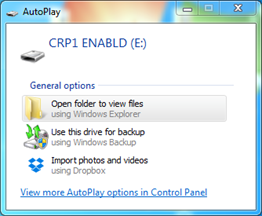 Fig. 10.1. Reconnecting as a mass storage device
Fig. 10.1. Reconnecting as a mass storage device
Delete the existing file “firmware.bin” and simply upload a new firmware file by dragging and dropping as in Fig. 10.2.
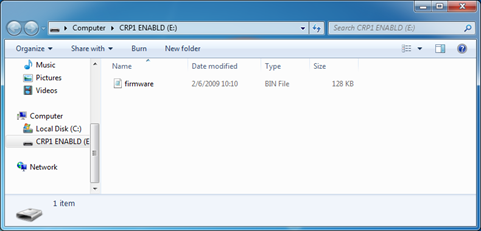 Fig. 10.2 Mass storage device for firmware upload
Fig. 10.2 Mass storage device for firmware upload
Reconnect the device and check the firmware version. It should have changed.
